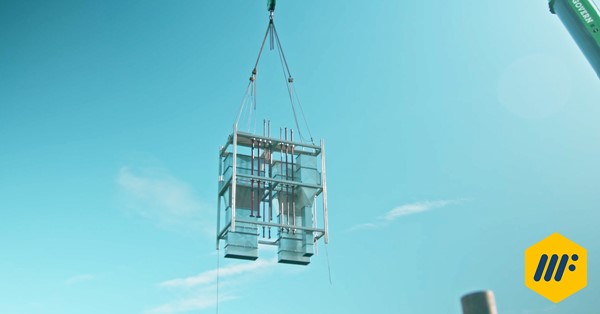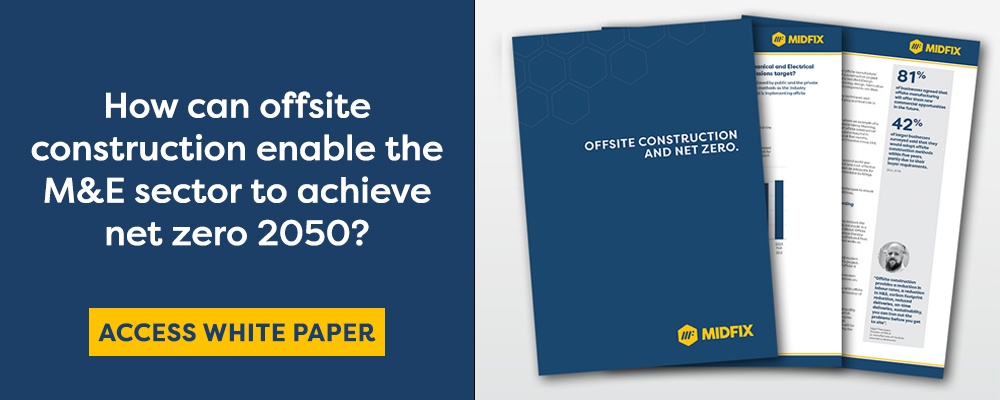How DfMA is helping building service contractors deliver projects on time.
As the principles of DfMA and modern methods of construction are becoming widely adopted by building service contractors we sat down with our technical salesmen Jake to ask what this means for building service contractors.
After reading this blog you will have an overview of DfMA, its principles, and how the philosophy is becoming widespread across the industry.
- What is DfMA
- How can DfMA and modern methods of construction help building service contractors?
- What are the key factors that influence the successful adoption?
- What are the barriers to the M&E industry?
What is DfMA
Design for manufacturing assembly is an engineering approach that focuses on reducing building time and costs of manufacturing. To achieve this, practices are put in place to streamline the manufacture and assembly of products. This all starts at the design phase of a product life cycle and should involve the whole of the supply chain.
Before it was seen as a singular philosophy, it was recognised as two separate approaches. Design for manufacturing (DFM) and Design for Assembly (DFA). DFM focused on cost-effective raw materials and attempted to simplify manufacturing methods during the product design phase to cut the overall time and cost. On the other hand, DFA focused on reducing the time and cost it took to assemble a product.
How can DfMA and modern methods of construction help building service contractors?
With construction output forecast to rise by 12.9% in 2021 and a further 5.2% in 2022 (construction products, 2021) building service contractors are becoming increasingly busy. Consequently, it makes sense for the sector to adopt the principles of DfMA.
For large projects where M&E contractors are responsible for supporting all services, their aim is for each project to be completed on time, within budget, and to follow best practices. To achieve these aims, all supports must arrive on-site as and when required and assembled correctly, quickly, and efficiently. If the principles of DfMA through modern methods of construction are implemented throughout the supply chain, supports can be designed and built to the highest standard, in volume, reducing the overall cost of the project to the contractor.
What are the key factors that influence the successful adoption?
Planning and communication
Two-way communication is vitally important between the principal contractor and the supplier as soon as a contract is awarded. This opens the opportunity to outline the design scope of work required on-site and to take into consideration any obstacles that could arise from the manufacture, delivery, and assembly of the support on-site.
Processes
A standardised process must be implemented throughout an organization from the delivery of parts, manufacture, and assembly of parts to delivery on-site.
Materials
To assemble a pipe or cable support efficiently, design needs to be optimised to only use what is required to support the loads, which reduces costs, waste and installation time.
Standards
Using standard parts or components will help to reduce the cost of a new design while improving stock management.
What can help drive the change?
Both private and public sector involvement can help drive the change. For contractors, the more projects completed on time, within budget, and to the highest standards will likely lead to their order books increasing. From their point of view, dealing with suppliers that have implemented DfMA principles reduces the risk of issues arising therefore suppliers will have to step up or miss out.
From a government standpoint, their aim is to create a more sustainable, zero-carbon, efficient and safer construction industry and this will be achieved through regulation changes and investment.
Government initiatives and timeline
- Autumn Budget 2017 – announces their commitment to Modern Methods of Construction for relevant departments
- In December 2017 ‘Transforming Infrastructure Performance’ publication set out a long-term programme to improve the performance and delivery of infrastructure assets.
- Specific proposals were drawn up to outline how this approach could be developed and used to deliver capital investment programmes. This is called ‘A platform approach to design for manufacture and assembly (P-DfMA), described in November 2018.
- 2019 saw the net-zero 2050 carbon emissions strategy set upon the construction industry.
- P-DfMA is an innovative approach to leveraging the government’s collective buying power to aggregate demand for platforms made up of digitally designed components, that can be used across different built assets, for instance, schools and hospitals.
- The government hopes that this will drive a new market for manufacturing in construction, provide a stable pipeline of demand to give the industry the confidence to invest in new products and manufacturing technologies. Ultimately delivering greater efficiencies through economies of scale and add value by providing infrastructure that performs better over its life cycle.
- Released November 2020 ‘The Construction Playbook’ is the next step for the P-DfMA journey and identifies how collaboration between government and industry can bring about positive change.
What are the advantages of DfMA?
If implemented correctly DfMA can transform the output of the construction industry and therefore the M&E industry.
- Health and safety – offsite manufacture and assembly requires skilled labour on-site but considerably less than a traditional construction project.
- Significantly reduce assembly times as quality standards have been implemented from the outset.
- Material wastage is reduced as DfMA processes have been implemented at the manufacturing stage helping the M&E sector to achieve its 2050 net-zero carbon emissions target.
- Large-scale DfMA adoption can increase the output of the construction industry.
What are the barriers to the M&E industry?
The construction industry willingness to adapt and change. For principal contractors, the coordination of trades and construction can be controlled on-site, if production was undertaken in a factory environment, it may erode the way they work.
Another key barrier to implementing this approach is that there is no universal proven procurement model. For the supply chain supporting the M&E industry, they are not always able to invest in digital technologies to improve efficiencies in the manufacturing and assembly of products.
In our own opinion, as a solutions provider to the building services industry, early engagement with principal contractors is critical to the smooth running of a project. Implementing DfMA and modern methods of construction in-house enables us to manufacture and assemble pipe and cable supports to the highest ISO 9001 and Euro codes standard, offset carbon emissions whilst enabling us to meet the demand.
REFERENCES:
Construction Products, 2021: 'Double-Digit Growth Forecast For Construction In 2021'
Government timeline: Proposal for a New Approach to Building: Call for Evidence - Summary of evidence.




